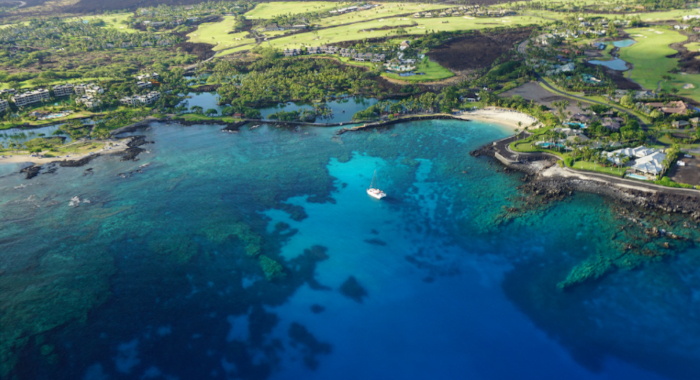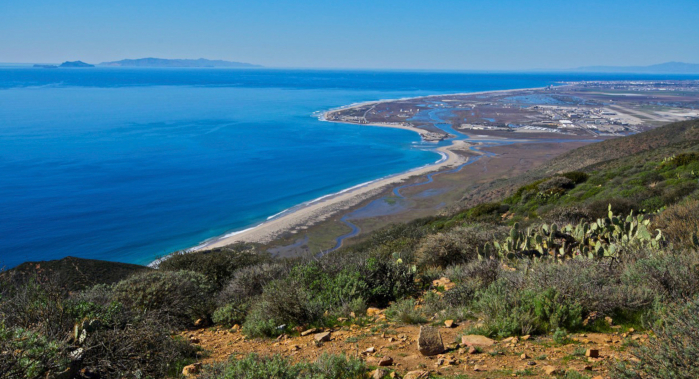Almost half of the world’s human population lives in coastal areas, and associated coastal development has significantly degraded or destroyed many coastal ecosystems. Burgeoning human populations and rising sea levels only further constrain the availability of habitat that coastal species depend on.
California’s 1,100 mile coast has more than 200 threatened, endangered or rare species living in coastal habitats. There are hundreds of coastal estuaries that provide critical rearing habitat for marine species, and are also important for recreation, water filtration, and carbon sequestration.
Only 10 percent of California’s historic coastal wetlands remain. Without intervention, we are at risk of losing 40 percent of our remaining coastal wetlands to sea level rise over the coming decades. Conservancy scientists are working to reverse these trends.


Environmental Science Associates (ESA) for The Nature Conservancy and Naval Base Ventura County
Charlotte Stanley, Alyssa Mann, Walter Heady
The United States operates thousands of military installations in the U.S. and worldwide, worth about $1.2 trillion. These facilities are where personnel train and test weaponry, with…Walter Heady, Alyssa Mann, Stacey Solie, Bob Battalio, James Jackson, Kendall Lousen, and Bob Barnes
The U.S. Congress and the Department of Defense (DoD) have determined that climate change is a threat to national security and have required military installations to develop plans to improve the…Alyssa Mann, Walter Heady, Charlotte Stanley
TNC and the United States Navy partnered together to prepare for the impacts of climate change on Naval Base Ventura County (NBVC), Point Mugu in California. NBVC is a critical and strategic asset of…Alyssa Mann, Walter Heady, Charlotte Stanley
Mary G. Gleason, Jennifer E. Caselle, Walter N. Heady, Vienna R. Saccomanno, Julie Zimmerman, Tristin Anoush McHugh, Norah Eddy
Global kelp forests are biodiverse and productive nearshore ecosystems that provide a wide range of ecosystem services, but they are at risk from both local stressors and global drivers of kelp loss.…Eric Gilman, Michael Musyl, Petri Suuronen, Milani Chaloupka, Saeid Gorgin, Jono Wilson, Brandon Kuczenski
More than 4.5 million fishing vessels deploy fishing gear in the ocean every year. A significant amount of these nets, traps, lines, and floats are abandoned, lost, or discarded, threatening the…Jennifer Sletten, Mimi D’Iorio, Mary G. Gleason, Alex Driedger, Timoth´e Vincent, Claire Colegrove, Dawn Wright, Virgil Zetterlind
Understanding the complex seascape of regulations that apply across U.S. ocean waters is critical for effective marine resource management. This study found that cumulative restrictions from…Bryan Legare, Bryan DeAngelis, Gregory Skomal
Broad-scale movements of highly migratory species, such as sharks, present unique management challenges as fish migrate across international boundaries, thereby exposing them to different levels of…Ray Hilborn, Ricardo Oscar Amoroso, Christopher M. Anderson, Julia K. Baum, Trevor A. Branch, Christopher Costello, Carryn L. de Moor, Abdelmalek Faraj, Daniel Hively, Olaf P. Jensen, Hiroyuki Kurota, L. Richard Little, Pamela Mace, Tim McClanahan, Michael C. Melnychuk, Cóilín Minto, Giacomo Chato Osio, Ana M. Parma, Maite Pons, Susana Segurado, Cody S. Szuwalski, Jono Wilson, Yimin Ye
Does fisheries management work at improving the status of fish stocks? The answer is a resounding, yes. This article compiles estimates of the status of global fish stocks, comprising roughly half of…Butterfield, H.S., M. Reynolds , M.G. Gleason, M. Merrifield, B.S. Cohen, W.N. Heady, D. Cameron, T. Rick, E. Inlander, M. Katkowski, L. Riege, J. Knapp, S. Gennet, G. Gorga, K. Lin, K. Easterday, B. Leahy, M. Bell
This Plan frames the biological and cultural significance and provides the short- and long-term goals, objectives, and priority actions for the Jack and Laura Dangermond Preserve.H.J. Walker Jr., Philip A. Hastings, John R. Hyde, Robert N. Lea, Owyn E. Snodgrass, Lyall F. Bellquist
In response to anomalously warm sea-surface temperatures, poleward shifts in the geographic range of hundreds of marine organisms worldwide have been documented. This paper reports on the unusual…Sean P. Fitzgerald , Hunter S. Lenihan, Jono R. Wilson, Carolynn S. Culver, Matthew Potoski
This paper highlights the benefits of collaborative fisheries research in the management of wild capture fisheries. The authors teamed up with commercial fishermen in the southern California…Laura S. Brophy, Correigh M. Greene, Van C. Hare, Brett Holycross, Andy Lanier, Walter N. Heady, Kevin O’Connor, Hiroo Imaki, Tanya Haddad, Randy Dana
The authors of this study generated new maps of current and historical tidal wetlands in 450 estuaries throughout Washington, Oregon, and California. Using laser-mapping technology known as LIDAR…Holmes ND, Spatz DR, Oppel S, Tershy B, Croll DA, et al.
Restoring islands by eradicating damaging, non-native invasive mammals such as rats, cats, goats, and pigs has repeatedly proven to be a high impact conservation action. New research…Rodríguez A, Arcos JM, Bretagnolle V, Dias MP, Holmes ND, Louzao M, Provencher J, Raine AF, Ramírez F, Rodríguez B, Ronconi RA, Taylor RS, Bonnaud E, Borrelle SB, Cortés V, Descamps S, Friesen VL, Genovart M, Hedd A, Hodum P, Humphries G, Le Corre M, Lebarbenchon C, Martin R, Melvin EF, Montevecchi WA, Pinet P, Pollet IL, Ramos R, Russell JC, Ryan PG, Sanz-Aguilar A, Spatz DR, Travers M, Votier SC, Wanless RM, Woehler E, Chiaradia A
Seabirds are amongst the most engaged species on our planet. Among these are petrels and shearwaters: species characterized by long ocean journeys for migration and feeding, and a dependence on…Nicholas D. Holmes, Olivier Langrand, Russell A. Mittermeier, Anthony B. Rylands, Thomas Brooks, Dena R. Spatz, James C. Russell, Wes Sechrest, Federico Méndez Sánchez, Cristina Mittermeier (Editor)
Covering only five percent of the land on our planet, islands are home to an estimated 20 percent of the world’s bird, reptile, and plant species, as well as the most astonishing examples of…Sean P. Fitzgerald, Jono R. Wilson , Hunter S. Lenihan
Despite the economic value of California fisheries, many lack information needed to determine if fishing is occurring at a sustainable level. The Southern California Rock Crab fishery in the Santa…Holmes ND, Keitt BS, Spatz DR, Will DJ, Hein S, Russell JC, Genovesi P, Cowan PE, Tershy BR
Indicators for tracking conservation efforts at a global scale are rare but important tools for understanding trends and measuring progress towards global conservation targets. Eradication of invasive…